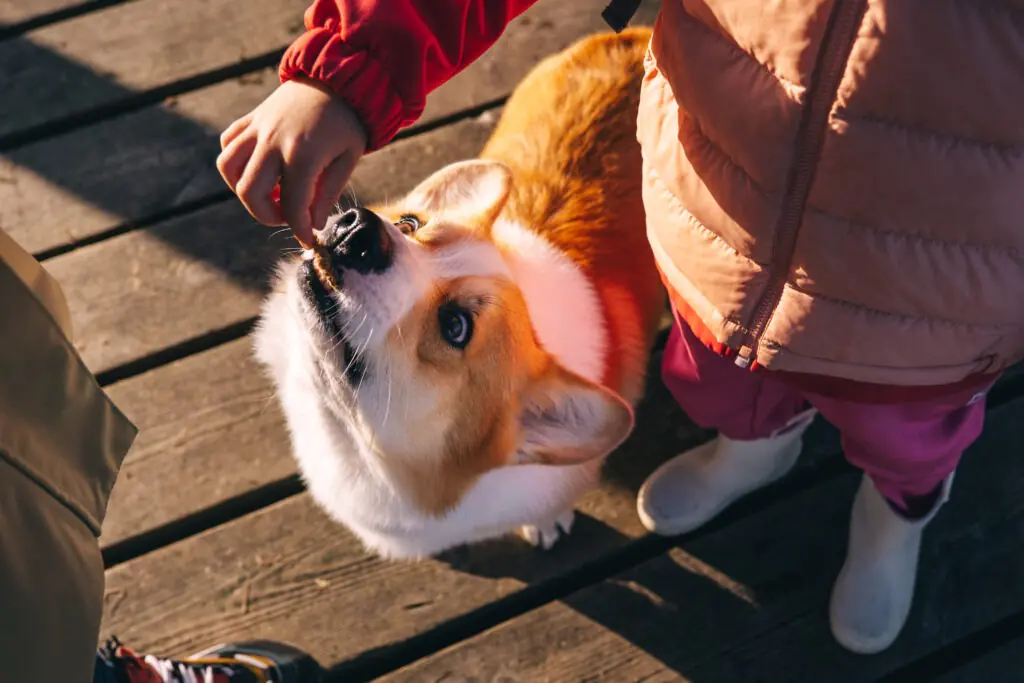
Having a family dog is one of the most rewarding experiences you can share, especially with children.
A pet dog is also a great way to teach children responsibility from a young age and help them build a bond. Plus, it helps children become comfortable and removes any nervousness around other people’s dogs too.
Another upside of involving kids in the training process is that it can also help them learn valuable life skills like patience, consistency, and empathy.
The process also teaches children responsibility and routine, which can help them in other areas of their lives. Working together to train the family dog strengthens the bond between child and pet, while creating a loving relationship built on mutual respect and understanding.
So, all in all, there’s plenty of brilliant reasons to involve your children in training your dog. Here are our top tips to help you safely and successfully involve children in dog training. Let’s go!
Age-Appropriate Dog Training Roles For Children
When involving your kids in dog training, remember to keep their roles age-friendly to help keep both themselves and your furry friend safe.
Age 3-5: The Cheerleaders
Young children can act as enthusiastic supporters and, more importantly for your pet, treat dispensers. They can help with simple tasks like holding dog treats during training sessions and celebrating when your pet succeeds. At this age, it’s a good idea to focus on teaching them gentle touch and basic safety around dogs rather than any actual training techniques. Always supervise your child when around dogs and never leave them unattended.
Age 6-9: The Assistant Trainers
Older children can begin learning basic commands with their dog and practicing them under adult supervision. They can help to teach simple commands like ‘sit’, ‘stay’, and come’. Children aged between 6 and 9 can also help with feeding routines and at this age understand the connection between repetition, hard work, and results.
Ages 10-13: The Co-Trainers
Pre-teens can take on more complex training tasks and understand the reasoning behind different techniques. This will help them as they transition into teenagers and navigate all those tricky hormones, too! Your kids can also work independently on reinforcing commands your dog already knows and help introduce new, more challenging training methods and understand their different approached.
Ages 14 and over: The Independent Trainers
Teenagers can handle most aspects of dog training independently. You could even give them more responsibility by getting them involved in researching advanced dog training techniques and getting their views on what would work best for your pet. They can work on specialised training like learning to walk on a lead, address behavioural issues, and preparing for more advanced activities such as teaching your dog agility skills.
Simple Commands Children Can Teach
The Foundation Commands
Start with ‘sit’ as it’s the most natural and easiest command for children to teach. Have your child hold a tasty treat above the dog’s nose, drift it back over their head, and say “sit” as the dog naturally sits to follow the treat.
The moment your pet sits, have your child say, “good dog” and give the treat straight away. Treats such as our Peanut Butter Flavoured Small Bite Bones are perfect for this kind of training as they’re small and easily broken down into bitesize pieces for quick (but delicious) rewards.
‘Stay’ builds on the sit command and teaches a dog impulse control. Once your furry friend is sitting, have your child hold up their hand in a ‘stop’ gesture, take one small step back, wait a few seconds, then return and reward. Gradually increase the distance and duration.
‘Come’ is crucial for safety and should be practiced in a secure, enclosed area. Have your child call the dog’s name followed by “come” while crouching down with open arms. When the dog approaches, immediately give them praise and plenty Pointer treats to reinforce the good behaviour, of course!
Remember practice makes perfect and your pet won’t learn these commands immediately, it takes time!
Building Complexity
As children master basic commands, they can progress to other commands such as ‘down’, ‘drop it’, and ‘leave it’. These instructions require more patience and consistency, so this may be better suited to older children, but provides excellent opportunities for your kids to practice their training skills and see their progress.
Making Training Fun and Engaging
A great way to make training fun and engaging, especially for younger children, is to include games that both children and dogs can enjoy. The Red Light, Green Light game can help to teach the ‘stay’ command, where children have the dog walk beside them and must ‘stay’ when they call “red light.”
Create training obstacle courses using household items, such as pillows to jump over or chairs to weave through. This makes training feel like play while helping to reinforce multiple commands in sequence.
Use positive reinforcement consistently by celebrating your dog’s every success, no matter how small. You can do this either by making a fuss over your dog or giving them a small treat such as our Grain Free Mini Dogs. This helps children to learn to praise immediately when the dog performs correctly.
Getting Started
Begin your family’s dog training journey by having a family meeting to discuss goals, assign responsibilities, and establish ground rules to keep everything safe. We’d recommend starting off with teaching one simple command first and practicing it consistently for a week before adding additional elements.
Remember that every dog, and every child, learns at their own pace. Be patient with the process and focus on making it enjoyable for everyone involved. The memories you create, and the lessons learned will benefit you and your family for years to come.
With proper guidance, safety measures, and age-appropriate responsibilities, involving children in dog training becomes one of the most rewarding experiences a family can share. Your children will gain valuable life skills, your dog will learn to be better behaved, and your family bonds will be reinforced.
We’d love to see how you train your pup as a family! Share your adventures with us on Instagram or Facebook. For more dog care tips and tricks, visit our blog.


